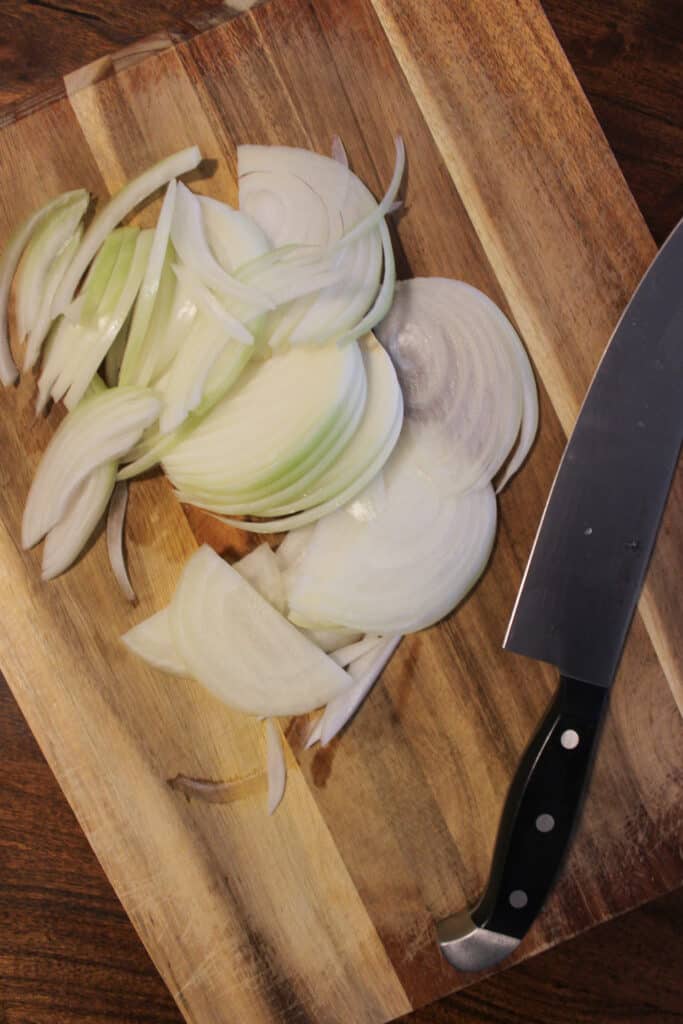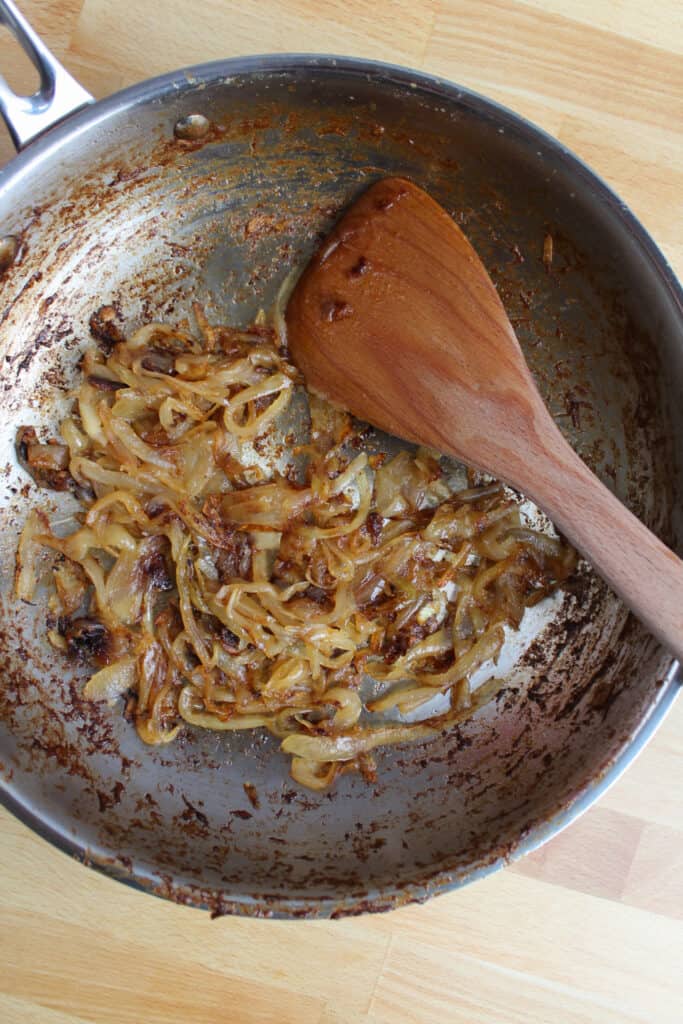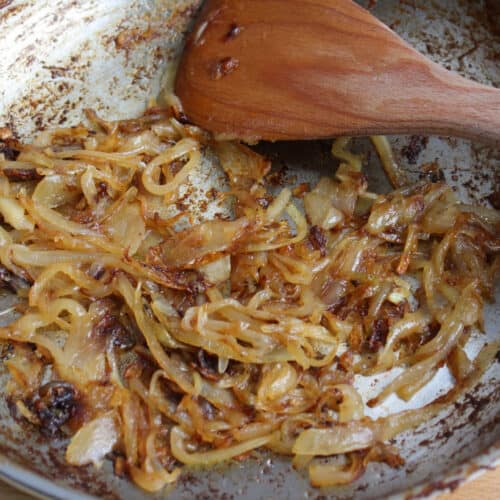How To Make Caramelized Onions
This post may contain affiliate links. As Amazon Associates and through other affiliate programs, we earn from qualifying purchases if you click on a link – at no extra cost to you. We only promote products we actually use and truly love!
Learn how to make the best caramelized onions at home with this fail-proof technique that yields perfectly sweet results every time.

Caramelized onions can feel like one of those advanced ingredients that you see on a restaurant menu as a topping for a burger or pizza, but would never think can be made so easily at home. But they are! This “specialty” ingredient doesn’t have to be hard to make – it just takes a little time and patience. So if you’re looking to make the best caramelized onions at home and recreate your favorite restaurant dishes, this step-by-step breakdown of how to make caramelized onions is for you.
Ingredients For Making Caramelized Onions
All you really need to caramelize onions are, well, onions. But other ingredients such as butter and sugar help both the cooking process and flavor profile.
Here is a full list of ingredients you need for this caramelized onion recipe:
- Yellow onion
- Vegetable oil
- Butter
- Salt
- Granulated sugar
- Water
Any type of onion can be used for caramelizing, but the most common caramelized onions are made with yellow onion as they provide the best balance of sweet and savory.

How To Make Caramelized Onions: Step By Step Instructions
Making caramelized onions is super easy. All you need is a large frying pan, some patience, and time. Follow the steps below and check out the FAQs section, and soon you will be making caramelized onions at home over and over again!
- First, peel and slice the onion. You can slice it as thick or as thin as you like, but note that thicker slices will take longer to cook since you need to draw out all the moisture from the onions. We like to slice the onion somewhat thinly since we like our caramelized onions a little stringy.
- Next, heat vegetable oil and butter in a large frying pan over medium-low heat. Once the butter is melted, add the sliced onions to the pan and stir to coat them in the oil and butter.
- Cook the onions until they become translucent, stirring occasionally. Then add the salt and sugar to help start the caramelization process – the salt will draw any extra moisture out of the onions and the sugar will aid in caramelization.
- Once the onions start to look dry, add about a quarter cup of water to the pan. Cook until the water has evaporated and the onions are dry again, stirring occasionally. Continue this process, cooking the onions over medium-low heat and adding some water to the pan whenever they look like they might start burning.
- The onions will be done once they’re a nice, even brown color and smell sweet. For more flavorful caramelized onions, you can continue cooking until they are a rich, deep brown. It’s really up to personal preference!
If at any point you notice the onions are browning too much around the edges (instead of evenly browning), it likely means they are starting to burn. Add more water to the pan and keep an eye on them as they cook. If they dry out too quickly, you may want to lower the heat.
Note: Different types of cookware and different types of stoves (gas vs. electric) can yield vastly different results. Don’t worry too much about the exact cooking times or measurements listed in the recipe. Instead, use sensory cues like how the onions look, smell, and sound to understand when it’s time to add more water, or if you need to adjust the heat. For more guidance on this concept, check out our post on intuitive cooking here.

Prep & Storing Tips
Since it does take a bit of time and patience to make caramelized onions, we recommend preparing them ahead of time for most recipes. This way, you can make a big batch all at once with one or two onions, and then have them at your disposal throughout the week.
After cooking, let the onions cool to room temperature before storing in an airtight container. Refrigerate for up to 5 days.
When it’s time to use them for a recipe, you can either add the cold onions to your dish if it’s going to be heated up (i.e. using them as a pizza topping before baking, or in a grilled sandwich), or warm them in a frying pan over medium-low heat until they’re the desired temperature.
How To Make Caramelized Onions: FAQs
Can you caramelize red onions? Yes! You can caramelize any type of onion you like. Just note that different kinds of onions have different flavors, so caramelized red onions will be more tangy than yellow onions.
What is the best liquid to caramelize onions in? For basic caramelized onions, the best liquid you can use is water since it’s always in your kitchen! If you want more flavor, we recommend caramelizing onions in beer, wine, or even balsamic vinegar.
Is it better to caramelize onions with butter or oil? Butter offers a richer flavor, while oil can be a healthier but still flavorful alternative. This is why we like to use both butter and oil in our caramelized onions! A little butter for richness, with a little oil to supplement.
Do you add salt or sugar to caramelized onions? Both! You should always add salt to caramelized onions as it helps draw out the flavors, while sugar helps the onions caramelize a bit faster than if you went without it. (It also adds a little extra sweetness, which we love). However, you don’t always have to add sugar to caramelized onions, since onions contain natural sugars that help them caramelize anyways.
Does salt help caramelize onions faster? Technically, yes. Salt will help draw moisture out of the onions, which you need to do in order for the onions to begin caramelizing!
Do you caramelize onions uncovered? We recommend cooking caramelized onions uncovered, since you want to avoid collecting too much moisture in the pan. The onions need to dry out to caramelize, which will happen more quickly and easily if the pan is uncovered.
Why are my onions not caramelizing? The most likely reasons are either there is too much moisture or they have not had enough time to cook. The onions need to dry out to caramelize, so make sure you are letting the water (or other cooking liquid) evaporate completely before adding more liquid.

Why You’ll Love This Recipe
While caramelized onions aren’t generally something you would eat on their own, they add great flavor to so many different dishes. Here are some of our favorite dishes to use caramelized onions in:
- Burgers – like this restaurant style pretzel pub burger
- Soup – caramelized onions are one of the most important ingredients in French onion soup
- Sandwiches – try this open faced brie sandwich or this decadent braised short rib grilled cheese
- Pizza – you can add caramelized onions to just about any pizza (perhaps one with goat cheese and arugula?)
Whatever you decide to use these caramelized onions for, we’re sure that you will continue to come back to them over and over as you find new ways to incorporate them into your home cooking.
If this recipe helped you take caramelized onions from a restaurant-only ingredient to a go-to at home, please rate, share, and comment below!
Love this recipe? You may enjoy these recipes, too:
- How To Make The Perfect Grilled Cheese
- Braised Short Rib Grilled Cheese
- Bacon Cheeseburger with Garlic Aioli
- BBQ Pulled Pork Pizza
To browse more of our latest recipes and seasonal dishes, visit our homepage here.
Like this recipe? Don’t forget to share it and follow us on Pinterest!

How To Make Caramelized Onions
Equipment
- Frying pan
Ingredients
- ½ large yellow onion sliced
- 1 tablespoon vegetable oil
- 1 tablespoon butter
- 1 teaspoon salt
- 1 teaspoon granulated sugar
- Water
Instructions
- First, heat the vegetable oil and butter in a large frying pan over medium-low heat. Once the butter is melted, add the sliced onions to the pan and stir to coat them in the oil and butter.
- Cook the onions until they become translucent, stirring occasionally, about 5 to 7 minutes. Then, add the salt and sugar to help start the caramelization process.
- Once the onions start to look dry, add about a quarter cup of water to the pan. Cook until the water has evaporated and the onions are dry again, stirring occasionally. Continue this process, cooking the onions over medium-low heat and adding some water to the pan whenever they look like they might start burning, until the onions are caramelized. This whole process can take anywhere from 30 minutes to an hour.The onions will be done once they’re a nice, even brown color and smell sweet. For more flavorful caramelized onions, you can continue cooking until they are a rich, deep brown.
Notes
Nutrition
If you have any questions regarding the information presented in this post, please refer to our Nutrition Disclaimer here.
Looking for kitchen inspiration? Head over to our shop to see what we cook with every day, plus recommendations for foodie gifts and eco-friendly products.
